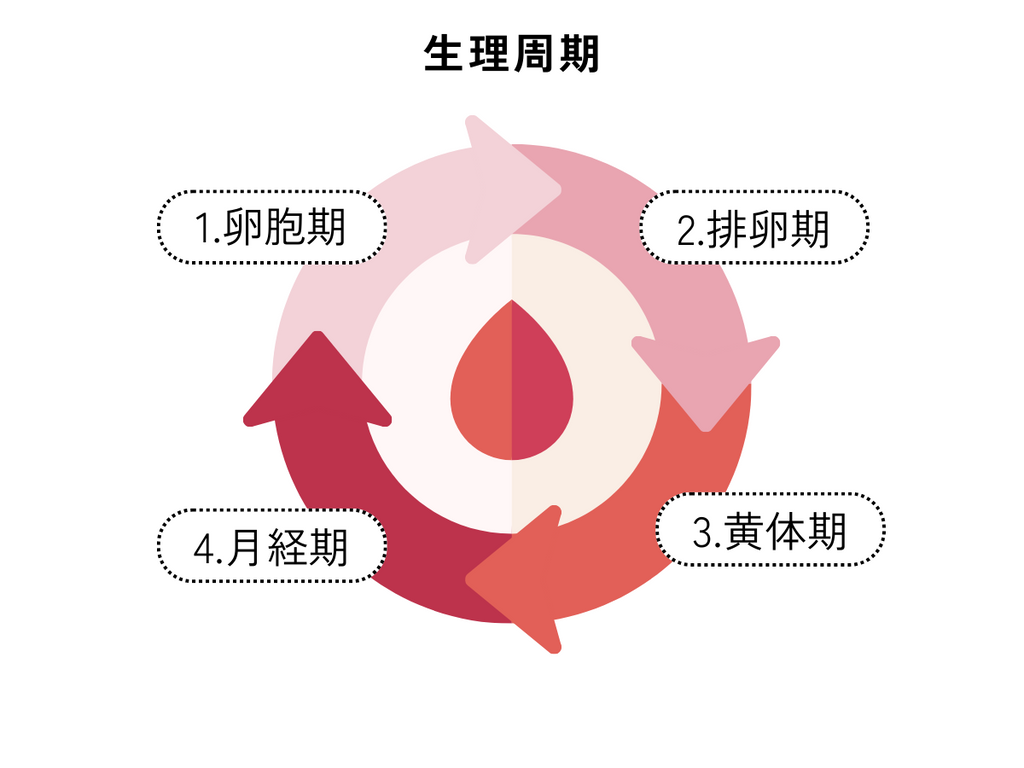A woman's menstrual cycle is closely linked to her mental and physical health. Small changes occur every day before and after menstruation.
However, there may not be many people who know their menstrual cycle accurately.
Here we will introduce the benefits of knowing your menstrual cycle.
There are four periods in the menstrual cycle

The menstrual cycle is broadly divided into four phases: the follicular phase, ovulation phase, luteal phase, and menstruation phase.
1. Follicular phase
This refers to the period from the end of menstruation to ovulation. The primordial follicles that produce eggs in the ovaries mature, the uterine lining gradually begins to thicken, and it is said to be the period when it is easy to get pregnant.
A lot of follicle hormone (estrogen) is secreted, the parasympathetic nervous system becomes active, and mood becomes stable.
2.Ovulation period
A mature egg is released from the follicle. This is called "ovulation." If the ovulated egg meets a sperm and fertilizes, pregnancy may occur. Although it varies from person to person, some people experience ovulation pain.
3. Luteal phase
The luteal phase begins after ovulation. After ovulation, the ruptured part of the follicle closes, forming a structure called the corpus luteum, which secretes the hormone progesterone to prepare for pregnancy.
During this period, your basal body temperature rises, stabilizing the uterine lining to make it easier for the fertilized egg to implant, and also promoting the development of the mammary glands.
If pregnancy does not occur, progesterone levels gradually decrease and the lining of the uterus begins to shed, causing menstruation.
The luteal phase, when estrogen decreases and progesterone increases, is also a time when women are more likely to experience PMS (premenstrual syndrome).
4. Menstrual period
If pregnancy does not occur, the uterine lining will be shed along with blood. This is the "menstrual phase."
In order for the endometrium to expel blood, it secretes a substance called "prostaglandin (the source of pain)" which stimulates uterine contractions. However, if the secretion of prostaglandin increases too much, the contractions become stronger, causing pain due to congestion and congestion around the uterus. Pain that makes daily life difficult is called "dysmenorrhea."
How to count your menstrual cycle
It refers to the period from the first day of your period to the start of the next period.
A normal menstrual cycle is said to last between 25 and 38 days.
For example, if your period starts on January 1st and your next period starts on January 29th, your menstrual cycle is said to be 28 days. However, since menstrual cycles do not come on fixed dates every month depending on your physical condition, it is recommended that you record your menstrual cycle about three times and calculate the average.
However, if your period ends in 1-2 days or continues for more than 8 days, there may be some problem with your physical condition.
What are the benefits of knowing your menstrual cycle?
1. It's easy to plan your trip
Have you ever had the experience of suddenly getting your period while traveling, staining your clothes and hotel bedding, or having to endure terrible period pain that prevented you from enjoying your trip?
By understanding your menstrual cycle, it will be easier to schedule days to go to hot springs, stay overnight, or do activities so that they do not overlap with your period.
2. You can understand your hormone balance.
Many people experience physical and mental instability due to hormonal imbalances, such as PMS (premenstrual syndrome) that occurs during the luteal phase. By understanding your menstrual cycle, you can understand not only your menstrual period but also the times when PMS is likely to occur.
By understanding your menstrual cycle, you can take measures such as consciously getting more sleep before your period, eating a balanced diet, and not over-packing your schedule.
3. You can detect the possibility of pregnancy early.
Knowing your menstrual cycle accurately will help you understand when you are most likely to get pregnant.
It also helps you to notice if your menstrual period is delayed.
4. Enhances beauty effects
During the follicular phase (about one week from the end of menstruation to ovulation), the parasympathetic nervous system becomes active, metabolism becomes active, and blood circulation improves, making it easier to reduce swelling and improving skin condition.
Therefore, it is ideal for skin care and hair removal, such as peeling and exfoliation, which require strong stimulation.
You can also expect the benefits of muscle training, making this a good time to diet.
summary
This time we'll talk about the menstrual cycle.
Knowing your menstrual cycle not only tells you when your period will come, but also allows you to understand your hormonal state.
Before your period, you may feel depressed or unwell due to PMS, but if you understand your menstrual cycle and hormonal state, you can take measures in advance.
To ensure you have the most peaceful days possible, why not check your menstrual cycle?



